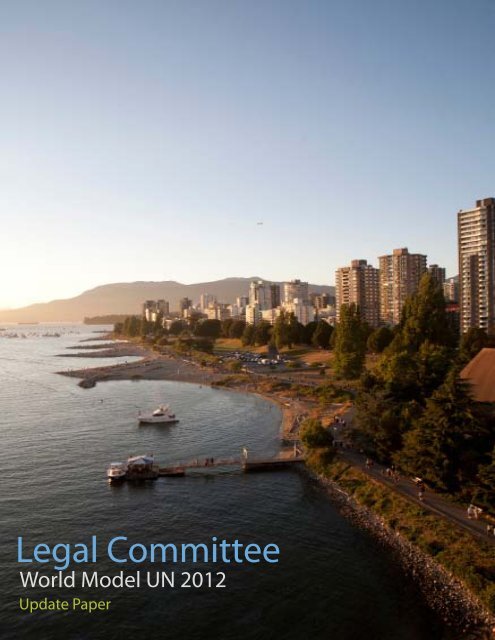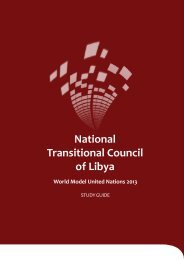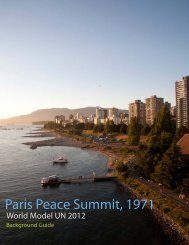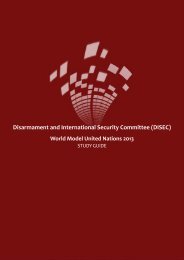Legal Committee - World Model United Nations
Legal Committee - World Model United Nations
Legal Committee - World Model United Nations
You also want an ePaper? Increase the reach of your titles
YUMPU automatically turns print PDFs into web optimized ePapers that Google loves.
<strong>Legal</strong> <strong>Committee</strong><br />
<strong>World</strong> <strong>Model</strong> UN 2012<br />
Update Paper
T o p i c A Upd AT e<br />
China and Vietnam Sign Deal on South China<br />
Sea Dispute<br />
After months of tension in 2011, China and Vietnam<br />
signed an agreement on the issue of the South China Sea<br />
in October. The deal put forward several measures, including<br />
the establishment of a hot-line to deal with emergencies and<br />
a provision for leaders from both sides to meet twice a year.<br />
It also mentioned that any final agreement on the border dispute<br />
should be based on international laws and be acceptable<br />
to both sides, and that there should be more co-operation<br />
such as scientific research in the area.<br />
India and Vietnam Reach Agreement on Joint<br />
Oil Exploration in South China Sea<br />
In October 2011, in company with a serious of pacts relating<br />
to the trade, security and strategic ties between the two countries,<br />
India and Vietnam came to an agreement that promoted<br />
joint oil exploration in the South China Sea. The deal was<br />
signed between Indian and Vietnamese state-owned oil companies,<br />
and included new investment and exploration of oil<br />
and gas in the area as well as supply of oil and gas to the two<br />
countries. Chinese authorities raised objections to the joint<br />
project and claimed that it was in Chinese maritime jurisdiction,<br />
which was in turn rejected by both India and Vietnam.<br />
Japan and Vietnam Agree on Defense<br />
Cooperation<br />
Also in October 2011, representatives from Japan and Vietnam<br />
signed a memorandum on defense cooperation and<br />
exchange relating to the issues in the South China Sea. To<br />
counter China’s increasing influence in the area, Vietnam<br />
sought to strengthen its relationship with Japan, and Japan<br />
was nominally in support of resolving the issues in a peaceful<br />
way. According to the memorandum, officials of vice defense<br />
minister-level from both countries would arrange regular dialogues,<br />
and the Japanese Self-Defense Forces and the Vietnamese<br />
military would also visit each other’s country.<br />
<strong>United</strong> States and Philippines Conduct Joint<br />
Military Drills Near the Disputed Spratly Islands<br />
Starting in late October 2011, the US and Philippines began<br />
two weeks of their annual joint military drills in the Philippines,<br />
including a hostile beach assault exercise near the<br />
Spratly islands that had always been in territorial dispute.<br />
The maneuvers were said to be not aimed at China or any<br />
other imaginary target country. “We’re assisting the Chinese<br />
in ensuring that their region is peaceful,” said the US Ma-<br />
rine 1st Lieutenant Nick Eisenbeiser. As a possible site for<br />
the joint drills, one of the Filipino-occupied islands was also<br />
said to be originally listed on the proposal but was delisted to<br />
avoid causing more hostilities.<br />
Philippines and Vietnam Cooperate<br />
In October 2011, presidents of the Philippines and Vietnam<br />
signed agreements to enhance maritime cooperation in<br />
the South China Sea. The pacts included information sharing<br />
between the navies of both countries, the creation of a<br />
hot-line between their coast guards, the protection of marine<br />
resources in the area, and so on. Both parties supported<br />
peaceful resolution of the issues within the framework of international<br />
law. Vietnam was also invited by the Philippines<br />
to invest in about 15 oil and gas blocks in areas that laid outside<br />
the disputed areas in the South China Sea.<br />
Increased Involvement of USA<br />
The ASEAN Regional Forum in the summer of 2011 at Bali<br />
saw the creation of an agreement between ASEAN and China<br />
to resolve the South China Sea disputes peacefully. However,<br />
the ASEAN-China agreement fails to address the drivers<br />
of potential conflict in the South China Sea. As ASEAN<br />
member countries realize that they have little ability to stand<br />
up to China; some member states have looked towards the<br />
USA as a potential ally over the issue of the South China Sea<br />
disputes.<br />
The USA has taken a firmer position in addressing the South<br />
China Sea disputes and it has allied herself with the South<br />
East Asian countries such as Philippines, Vietnam, and Singapore<br />
amongst others. America’s increased involvement in<br />
the South China Sea disputes may be necessary to protect international<br />
maritime traffic and not rely on China to “grant”<br />
such rights to maritime travel in the South China Sea. This<br />
tough response to China may be necessary since it is highly<br />
unlikely that China will agree to any written code of conduct<br />
about the waters in the near future. 1<br />
Balance of Powers<br />
USA’s military exercises in the South China Sea with Philippines<br />
and Vietnam have shown increased interest in the<br />
South China Sea by the USA. While the USA has no direct<br />
concerns in the South China Sea dispute, it has an interest in<br />
maintaining the balance of powers between China and the<br />
other nations. Countries involved in the South China Sea<br />
dispute want to resolve the issue peacefully and they look towards<br />
USA for guidance on this issue.<br />
USA’s involvement in the South China Sea is to prevent Chi-<br />
Harvard <strong>World</strong>MUN 2012 <strong>Legal</strong> 22
na from flexing its maritime muscles to claim the territories<br />
around the South China Sea. However, if China has a drastic<br />
reaction, the US will stop its provocation. The US will not<br />
allow the provocations of small countries to result in a war. 2<br />
Increased USA Military Presence in the Asia<br />
Pacific Region<br />
USA has signed an agreement with Australia which will allow<br />
thousands of USA naval forces to train alongside the<br />
Australian military. While the agreement does not include<br />
any permanent US bases in the region, it does offer the USA<br />
an easier access to the South China Sea as compared to the<br />
US bases in Japan or South Korea. 3<br />
Chinese Response to the USA<br />
China has warned that the South China Sea dispute should<br />
be resolved by sovereign countries in the region and not<br />
rely on foreign countries. China establishes the interest of<br />
a peaceful and friendly resolution of the conflict and warns<br />
against external forces using the South China Sea dispute as<br />
an excuse to enter and exert influence in the region. 4<br />
Declaration of Conduct in Beijing<br />
Both Beijing and Washington have established meetings and<br />
conferences towards addressing the disputes in the South<br />
China Sea. Both events sought to reinforce the viewpoints<br />
of both nations. China seeks to resolve the issue only with<br />
the key nations in the region and does not welcome USA’s<br />
entrance. USA sees the value of maintaining a presence in<br />
Asia Pacific and seeks to be involved in the discussion pertaining<br />
to the South China Sea disputes. It is submitted that<br />
both countries are unwilling for the disputes to escalate into<br />
military actions. This will allow discussions to proceed with a<br />
diplomatic framework in mind amongst the parties. 5<br />
US - Singapore Strategic Partners Dialogue<br />
USA officials have met with Singapore officials to discuss “an<br />
already robust array of initiatives” to address the disputes in<br />
South China Sea. This follows after a recent call by Secretary<br />
of State Hillary Clinton for the U.S. to “pivot” its strength to<br />
Asia.<br />
She elaborates, the <strong>United</strong> States has helped “to protect unfettered<br />
access to and passage through the South China Sea,<br />
and to uphold the key international rules for defining territorial<br />
claims in the South China Sea’s waters. Given that<br />
half the world’s merchant tonnage flows through this body of<br />
water, this was a consequential undertaking.” 6<br />
Similarly, the commander of U.S. forces in the Pacific and<br />
Asia, Admiral Robert Willard, has noted: “The sea lines of<br />
communication that crisscross the South China Sea carry<br />
$5.3 trillion in bilateral annual trade, of which $1.2 trillion<br />
is U.S. trade.” 7<br />
Willard, who has sought to get his staff and subordinates to<br />
think more strategically, said the U.S. has had a “continual<br />
presence” there and seeks a dialogue with the Chinese so<br />
“they will constructively contribute to the security of this vital<br />
region.” 8<br />
Center for a New American Security: Cooperation<br />
from Strength<br />
The South China Sea functions as the throat of the Western<br />
Pacific and Indian Oceans – a mass of connective economic<br />
tissue where global sea routes coalesce, accounting for $1.2<br />
trillion in U.S. trade annually. It is the demographic hub of<br />
the 21st-century global economy, where 1.5 billion Chinese,<br />
nearly 600 million Southeast Asians and 1.3 billion inhabitants<br />
of the Indian subcontinent move vital resources and exchange<br />
goods across the region and around the globe. It is an<br />
area where more than a half-dozen countries have overlapping<br />
territorial claims over a seabed with proven oil reserves<br />
of seven billion barrels as well as an estimated 900 trillion<br />
cubic feet of natural gas. 9<br />
Because the <strong>United</strong> States needs to maintain cooperation<br />
with China, America’s individual strategic partnerships in<br />
Southeast Asia are likely to be the essential building blocks<br />
of a latent regional alliance that would only coalesce in the<br />
event of a clear and present danger,” it suggests. “Strategic<br />
partnerships based on strong common interests (in effect,<br />
tacit alliances) can be stronger than formal alliances and are<br />
less likely to provoke a hostile Chinese response (as opposed<br />
to harsh rhetoric) that would polarize the region. This last<br />
point is especially valid if the region continues to build understanding<br />
and practical cooperation with China.<br />
W o r k s ciTed<br />
http://www.bbc.co.uk/news/world-asia-pacific-15273007<br />
http://www.indianexpress.com/news/india-vietnam-joinhands-for-oil-exploration-in-south-china-sea/858958/<br />
http://ajw.asahi.com/article/behind_news/politics/<br />
AJ2011102515718<br />
http://www.guardian.co.uk/world/feedarticle/9898523<br />
http://www.siiaonline.org/?q=programmes/insights/updatesouth-china-sea-developments<br />
Harvard <strong>World</strong>MUN 2012 <strong>Legal</strong> 33
E n d n ot E s<br />
1 http://www.cfr.org/china/growing-us-role-southchina-sea/p26145<br />
2 http://www.globaltimes.cn/NEWS/tabid/99/<br />
ID/681576/US-has-no-stomach-for-South-China-Sea-military-clash.aspx<br />
3 http://www.dailymail.co.uk/news/article-2061914/<br />
South-China-Sea-dispute-Obama-increase-US-militarypresence-Asia-Pacific-region.html<br />
4 http://www.bbc.co.uk/news/world-asia-15790287<br />
5 http://globalresearch.ca/index.<br />
php?context=va&aid=28746<br />
6 http://www.civilbeat.com/<br />
articles/2012/01/20/14645-the-rising-east-walsh-looks-tomackinder-for-naval-strategy/<br />
7 Ibid.<br />
8 Ibid.<br />
9 http://the-diplomat.com/the-editor/2012/01/21/us-in-the-south-china-sea/<br />
Harvard <strong>World</strong>MUN 2012 <strong>Legal</strong> 44

















